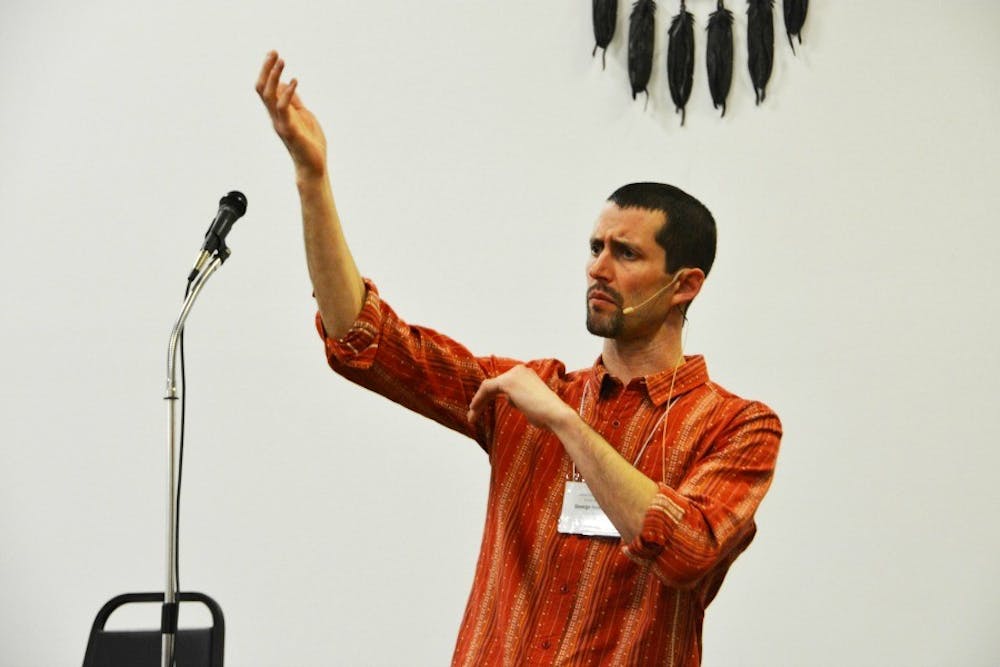By Bonnie Meibers, Senior Staff Writer
The place on campus that celebrates the Myaamia people most, the Wiikiaami Room, is tucked away in the depths of the Armstrong Student Center.
A panel of photographs and information in the Shade Family Room displays information about the Miami Tribe.
"We're more than just a pillar in the [Shade] Family Room," said Zach Roebel, a sophomore Myaamia student.
In the future, however, there will be a much more visible outdoor site on campus that represents the tribe in a unique and symbolic way.
Megan Mooney, also a sophomore Myaamia student, knew very little about her heritage before coming to Miami.
"I personally didn't know the name of the tribe until my sister applied here," she said.
Since coming to Miami, Mooney has become much more aware of her ancestors' history. She and the other Myaamia students take a Heritage Class in which they learn about the language and culture of the tribe as well as ecology and contemporary issues.
Roebel and Mooney, along with several other Myaamia students and a sophomore architecture student, have been helping to plan a site that will represent the tribe's origin, culture and history.
Every Friday at 4 p.m. since the beginning of the semester, meetings about the site have been held at the Myaamia Center in the Bonham House on Spring Street. At these meetings, university architect emeritus, Bob Keller, suggested ideas to the team of students and Myaamia Center staff. The group of six to eight students even pitched some ideas of their own to Keller.
A major goal of the group was to create a site with educational value that could teach students about the Miami Tribe.
Keller is no stranger to these types of projects. In the past, he has worked on the Freedom Summer project on Western Campus and the three dimensional seal in the second floor of the Armstrong Student Center.
The project, with a working title of Kihcikama, meaning "the lakes," is set to break ground sometime in 2017. However, since the project will be entirely funded by donations, the start date is tentative. Keller hopes to get donations from alumni.
The center of the site will feature a pond in the shape of the watershed of the The Great Lakes. The Great Lakes design will reflect the Myaamia origin story in which the Myaamia people emerged from the St. Joseph River in southeastern Michigan. On the perimeter around the pond will be the names of other tribes who lived in the area.
There will also be a terraced hillside overlooking the pond, similar to stairs. They will be made of large, rough natural stone. There will be lunar phases on the face of these terraces. The lunar phases are important to the Myaamia culture because the tribe once used them to track time and stay in tune with the ecology around them.
A gathering tree is another important feature of this site. In every Myaamia village, the tribe would designate a particular tree to gather around and discuss important issues. For this reason, a gathering tree has been designated in Kihcikama.
Markers representing the origin of the Myaamia people and their eventual removal to Kansas and Oklahoma will also be present. They will be a subtle feature, said Keller, but since the removal is a part of the Miami Tribe's history, it is unavoidable and an important symbol to the project.
"They have a past, present, [and] future like everybody does," Keller said.
The sandhill crane is the longest known symbol of the Myaamia Tribe used to mark their presence on trees and used as a signature on treaties, said George Ironstrack, assistant director of the Myaamia Center. The turtle is also important to the Myaamia culture.
Because the sandhill crane and the turtle are so important to the Myaamia people, there has been talk of having a sculpture of a crane standing on top of a turtle near the pond, representing the origin of the Miami Tribe and additional sculptures of a sandhill crane and a turtle at the spots symbolizing Kansas and Oklahoma looking back at the other sculptures, representing a link between the Myaamia people through time.
Kaihcikama will be situated next to the band practice field on Route 27. This location was chosen because there is parking and an auditorium nearby. It was also important to the group that students walking past and cars driving by could see the site.
"It's also going to be another nice gathering place if you want to get away from things or meet up with friends," Keller said.

